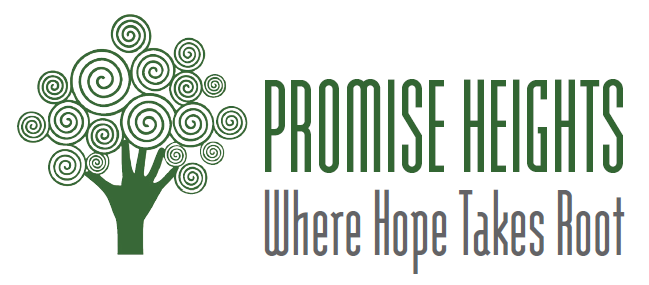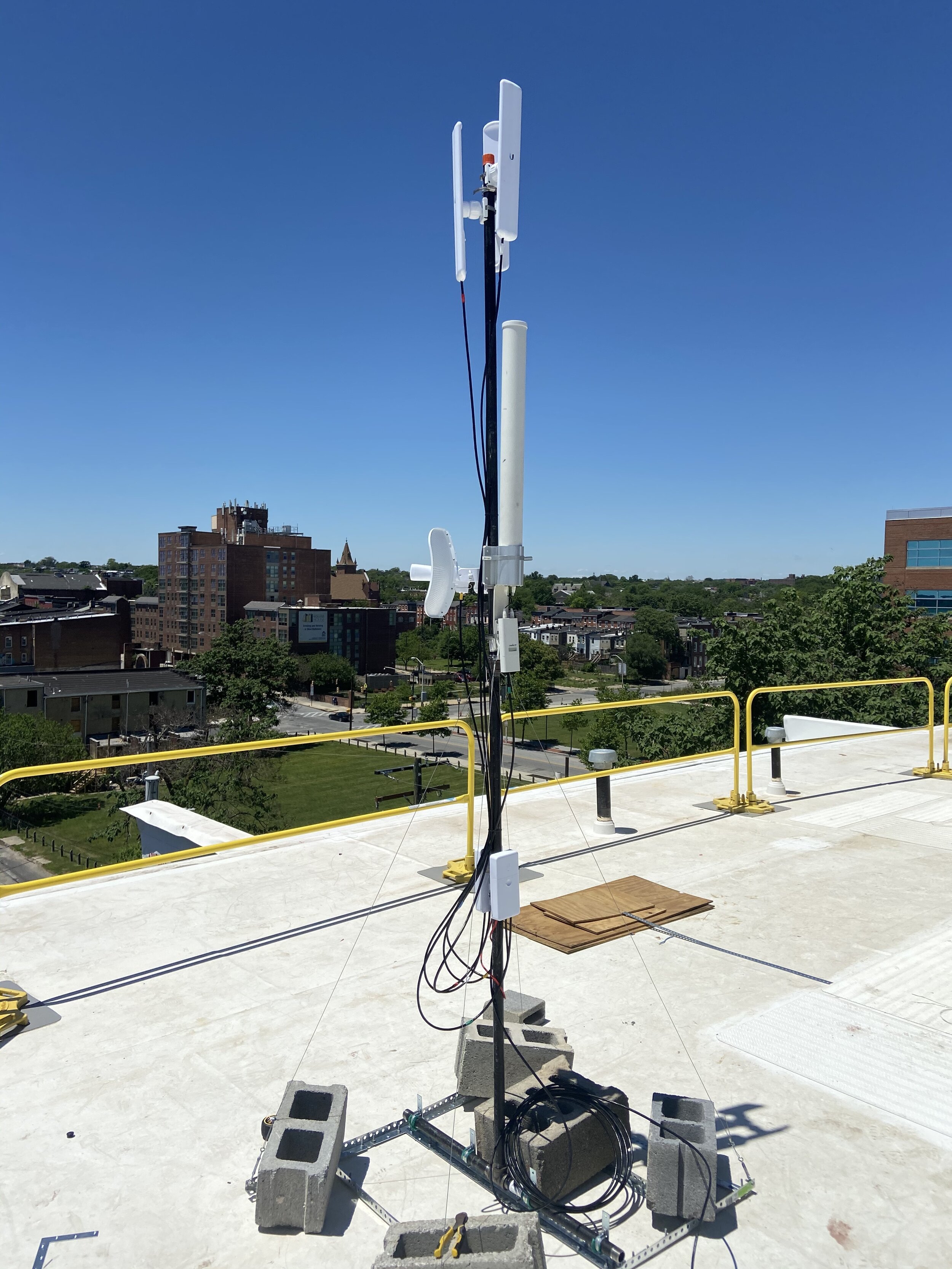Bridging Baltimore's Digital Divide
(Our first in a series of features regarding the expansion of internet access throughout Baltimore)
The Project Waves team atop the Exelon Building on October 1, 2020
“Where we are at this point is that we’ve finished setting up the tower on the Exelon Building, and it will be “lit up” on Friday [October 2,] which is super exciting! Then after some maintenance to infrastructure we built-out over the summer, the new antenna enables Project Waves to scale operations connecting over 200 families before the new year"
“At this point, we’re advancing a multifaceted approach. We’re installing towers on Baltimore’s taller buildings to broadcast wireless internet signals to individual homes. Yet wireless infrastructure is incredibly fragile, and in the long run, it’s a temporary solution. In the future—the coming years—we’ll likely be looking for more viable ways to broadcast internet without antennas. Yet now it’s a great solution.”
In collaboration with Project Waves and the Digital Harbor Foundation, UMB's Community Engagement Center (CEC) Program Coordinator Barnard Smit, is providing WiFi to residents in the Promise Heights footprint
Baltimore was America’s first city to install a gas-powered streetlight in 1817, yet when it comes to high-speed internet, we have fallen short of reaching a similar technological prowess. In recent decades and—depending where one lives in the city—most Baltimore residents are familiar with the limited and frustrating options for accessing high speed internet, given limitations in providers and vast irregularities in service speeds.
Friday, October 2, 2020 was an important moment for West Baltimore, when massive elements in the city’s longstanding “digital divide” was breached by a powerful wireless internet signal broadcasting from a tower atop one of the city’s tallest buildings.
Yet to understand how and why these changes are actually happening now, let’s back up.
When the pandemic first hit and public schools abruptly closed last spring, countless families with school aged children across the nation found themselves without access to decent computers. If that wasn’t enough, many were without an internet connection in their homes, so they were left in the lurch without what’s considered the most essential 21st Century public utility, nearly a decade after the United Nations declared internet access is a basic human right.
While our Promise Heights team scrambled to find laptops and mobile devices for students in our Upton/Druid Heights Community Schools, rather than asking ourselves, “how did this happen?!” we asked, “what can we do to resolve this dilemma?” We set short term and long term goals, applied for funding assistance, and built important new partnerships.
Project Waves’ small antennas are secured to various tall buildings throughout Baltimore
These simple antennas emit powerful wireless signals
This Baltimore City Dept. of Planning map highlights neighborhoods that lack access to internet
To receive a signal in homes, all that’s needed is to aim a simple Project Waves dish towards the antenna
Ever community-minded, the Enoch Pratt Free Library quickly scrambled for creative solutions—much like when their doors remained open in the days following Freddie Gray’s death. Once again, they became local heroes, first by strengthening WiFi signals in several branch libraries and publicizing these locations while welcoming everyone to use their parking lots to grab free internet signals. Soon afterwards, the library equipped and sent out mobile vans to broadcast WiFi in various neighborhoods, and again alerted communities about this free public service.
Undoubtedly these solutions helped many Baltimoreans without access to the internet. Yet anyone using this kind of temporary solution also faced pesky issues: an automobile functioning as an impromptu parking-lot workspace is an impractical option when an entire family needs wireless access, or worse, is impossible if they don’t own a vehicle. And open wireless service ignores the need to maintain net security, an essential for anyone managing family finances or attending to other personal business.
Meanwhile, before the COVID-19 pandemic changed just about everything, Barnard Smit, UMB’s Program Coordinator at the Community Engagement Center (CEC) was planning to facilitate and deploy UMB’s new “Maker Space” to help UMB students experiment and rapidly develop innovative technology projects. Smit expected to bring his skills as a critical and conceptual thinker adapting/maximizing hardware and software and as a mentor/educator to support experiential learning. Then suddenly, Baltimore City Public Schools closed, as well as UMB and every other educational institution. Each emptied campuses, sending their students to work from home. The reality was that few homes in Baltimore—and especially Upton/Druid Heights—were prepared for this abrupt transition.
We now know that eight months later, nearly all of these schools have yet to reopen, although this most immediate and unexpected issue opened a door for visionaries like Smit and a newly emerging Baltimore-based non-profit called Project Waves.
You’ve never heard of Project Waves? Founded in 2018, its smart moves were featured in the July 17, 2020 UMB news story, "Wi-Fi for All: UMB Partners with Project Waves. And this Community Internet Service Provider’s mission perfectly aligns to Promise Heights community needs: “to provide Internet access to all regardless of ability to pay, while closing the technology gap that disproportionately affects low-income and minority households by providing highly available, transparent, and reliable internet access to families across the city.”
Given Smit’s previous affiliation with the Digital Harbor Foundation—Project Waves’ fiscal sponsor—and our own ambition to quickly supply students of Upton/Druid Heights with a means to do their studies from home, we saw the opportunity for a perfect partnership.
This past summer Promise Heights Executive Director Bronwyn Mayden and our Director of Strategic Partnerships, Christian Edge toured the Upton/Druid Heights neighborhood with Bernard Smits, scouting for the most effective buildings as hosts for new transmission towers to bring internet access to hundreds of families in West Baltimore. Meanwhile, Smit continued similar scouting throughout Baltimore, strategizing and gaining permission from building owners to erect small towers on various roofs around town.
BETWEEN THEN & NOW:
Smit is a multifaceted designer focused on technology, experienced in research, development, and planning industrial design projects. As a critical and conceptual thinker who makes use of both hardware and software to bring the digital world to life, clearly, he was in the right place at the right time. Within weeks after schools shut down, Smit was setting up wireless networks sourced from the Baltimore Robotics Center and the Baltimore City Public Schools. These temporary networks were effective, yet they weren’t optimal, as even the slightest interruption by trees or buildings can blitz a signal.
He explained, “So far, we’ve set up 70 hotspots in the city. Yet this is not the same as the unsecured WiFi of last spring. You know, imagine if you go to a doctor’s office and talk about sensitive things, it’s not the same thing as sitting in your own home in private and comfort.”
“The good news is that Project Waves recently became an intermediary for this service, so now we’re in control of this signal, and we are responsible to pay the bills, so people can’t be rejected due to credit history problems. We’ve been providing families with routers in their homes that are partitioned for two signals—one is private and secure access for your family to use, and the other is a public access point for other nearby neighbors to use.” He briefly reflected, “Sure, there are challenges. Omni-directional signals are mostly strong for about three-tenths of a mile. Comcast estimates about seven-tenths of a mile formally, though high rises often interrupt that signal and often close that distance down.”
“Where we are at this point is that we’ve finished setting up the tower on the Exelon Building, and it will be “lit up” on Friday of this week [October 2], which is super exciting! Then after some maintenance to infrastructure we built-out over the summer, the new antenna enables Project Waves to scale operations connecting over 200 families before the new year"
He continued, “After that, I have that whole list of sites in Promise Heights—we’ll go and directly connect each of them to the Exelon Building. That will enable us to move really quickly with the home installs,” when his team will hook up wireless receivers in private homes throughout Upton/Druid Heights.
LOOKING BACK IN TIME & TOWARDS THE FUTURE:
As mentioned at the start of this blog post, we’ve been considering that during the 19th century, Baltimore was a leader of technological innovation, introducing the nation’s first gas powered streetlight that illuminated the intersection at what is now Baltimore and Holliday streets. On February 7, 1817, that single gas streetlight cast a far brighter light that any other previous human invention.
Much like that first streetlight, installed less than a year after the concept of gaslight was introduced in Baltimore, it’s important to recount the efficient speed that Baltimore leaders took to embrace that new technology, believing that gas light service was essential for our community. Yet since limited steps were made during the next twenty years, with only two miles of gas pipes installed throughout the city, it is also a reminder that without an impetus to offer these services equitably and to all, the benefits of new technologies can be stymied for decades.
In fact, as most residents of Baltimore well know, similar inconsistencies have existed throughout the city regarding high-speed internet service, available only in several well-off neighborhoods, while wide swaths of Baltimore have limited or spotty internet access. Given that traditional landline telephone wires are phasing out around the nation, quick infrastructure changes have been paused in most cities and rural areas for many years.
So ironically, the tragic arrival of the COVID-19 pandemic may also be the game-changer that we’ve long awaited, for it has provided funding to help bring equity to the people of West Baltimore.
At this point, now that the WiFi signal is live, it might help to think of each element that Smits and his team will arrange as being like a complex jigsaw puzzle, where each piece needs to be identified and precisely re-calibrated to aim towards the newly transmitting Exelon Building. It’s a slow and tedious process, yet fully worth it, as the speed will be faster than current services and the access will bring internet access to families who have waited so long to join the 21st Century.
We plan to keep you posted regarding the upcoming advances, and we hope to share success stories about ways this new internet access has benefited the children and families of Upton/Druid Heights during what has otherwise been a very tough year.
Given the immensity of this historic technological step we’ve made in 2020, we’re looking back to when Baltimore installed America’s first gas-powered streetlight
As recounted in a recent Baltimore Sun feature on the 200th anniversary of that first streetlight,
“It started as a tourist attraction in June 1816 when Rembrandt Peale…. used gas to light exhibits in his recently founded museum in Baltimore…. Visitors were drawn like moths to a flame, fascinated by what the Federal Gazette and Daily Advertiser described as ‘the beautiful and most brilliant light,’ which was less smoky and brighter than the whale oil that was standard at the time. Within a week, the City Council authorized the Gas Light Company of Baltimore, founded by Peale and some of the city's most influential businessmen, to lay pipes for a gas system that would replace the city's hundreds of whale oil lights…”
A replica of the nation’s first gas
streetlight stands at the original site






